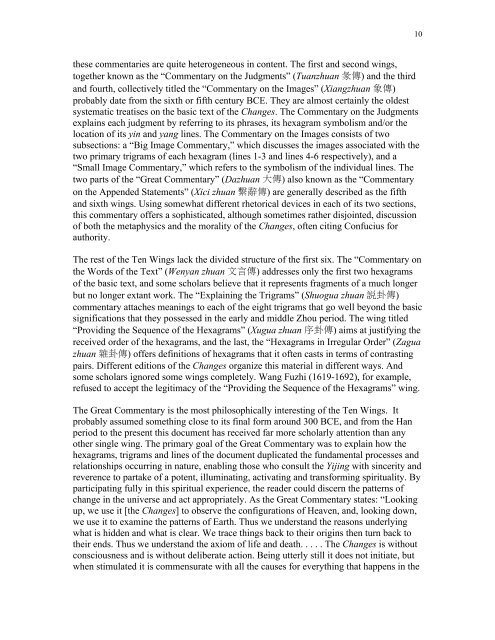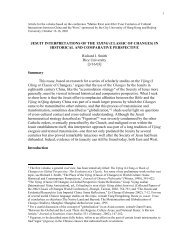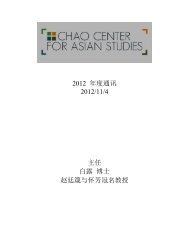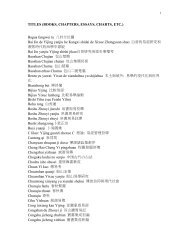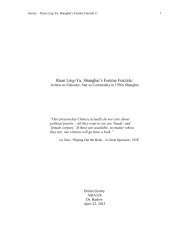Key Concepts of Fate and Prediction in the Yijing - Chao Center for ...
Key Concepts of Fate and Prediction in the Yijing - Chao Center for ...
Key Concepts of Fate and Prediction in the Yijing - Chao Center for ...
You also want an ePaper? Increase the reach of your titles
YUMPU automatically turns print PDFs into web optimized ePapers that Google loves.
10<strong>the</strong>se commentaries are quite heterogeneous <strong>in</strong> content. The first <strong>and</strong> second w<strong>in</strong>gs,toge<strong>the</strong>r known as <strong>the</strong> “Commentary on <strong>the</strong> Judgments” (Tuanzhuan ) <strong>and</strong> <strong>the</strong> third<strong>and</strong> fourth, collectively titled <strong>the</strong> “Commentary on <strong>the</strong> Images” (Xiangzhuan )probably date from <strong>the</strong> sixth or fifth century BCE. They are almost certa<strong>in</strong>ly <strong>the</strong> oldestsystematic treatises on <strong>the</strong> basic text <strong>of</strong> <strong>the</strong> Changes. The Commentary on <strong>the</strong> Judgmentsexpla<strong>in</strong>s each judgment by referr<strong>in</strong>g to its phrases, its hexagram symbolism <strong>and</strong>/or <strong>the</strong>location <strong>of</strong> its y<strong>in</strong> <strong>and</strong> yang l<strong>in</strong>es. The Commentary on <strong>the</strong> Images consists <strong>of</strong> twosubsections: a “Big Image Commentary,” which discusses <strong>the</strong> images associated with <strong>the</strong>two primary trigrams <strong>of</strong> each hexagram (l<strong>in</strong>es 1-3 <strong>and</strong> l<strong>in</strong>es 4-6 respectively), <strong>and</strong> a“Small Image Commentary,” which refers to <strong>the</strong> symbolism <strong>of</strong> <strong>the</strong> <strong>in</strong>dividual l<strong>in</strong>es. Thetwo parts <strong>of</strong> <strong>the</strong> “Great Commentary” (Dazhuan ) also known as <strong>the</strong> “Commentaryon <strong>the</strong> Appended Statements” (Xici zhuan ) are generally described as <strong>the</strong> fifth<strong>and</strong> sixth w<strong>in</strong>gs. Us<strong>in</strong>g somewhat different rhetorical devices <strong>in</strong> each <strong>of</strong> its two sections,this commentary <strong>of</strong>fers a sophisticated, although sometimes ra<strong>the</strong>r disjo<strong>in</strong>ted, discussion<strong>of</strong> both <strong>the</strong> metaphysics <strong>and</strong> <strong>the</strong> morality <strong>of</strong> <strong>the</strong> Changes, <strong>of</strong>ten cit<strong>in</strong>g Confucius <strong>for</strong>authority.The rest <strong>of</strong> <strong>the</strong> Ten W<strong>in</strong>gs lack <strong>the</strong> divided structure <strong>of</strong> <strong>the</strong> first six. The “Commentary on<strong>the</strong> Words <strong>of</strong> <strong>the</strong> Text” (Wenyan zhuan ) addresses only <strong>the</strong> first two hexagrams<strong>of</strong> <strong>the</strong> basic text, <strong>and</strong> some scholars believe that it represents fragments <strong>of</strong> a much longerbut no longer extant work. The “Expla<strong>in</strong><strong>in</strong>g <strong>the</strong> Trigrams” (Shuogua zhuan 説 )commentary attaches mean<strong>in</strong>gs to each <strong>of</strong> <strong>the</strong> eight trigrams that go well beyond <strong>the</strong> basicsignifications that <strong>the</strong>y possessed <strong>in</strong> <strong>the</strong> early <strong>and</strong> middle Zhou period. The w<strong>in</strong>g titled“Provid<strong>in</strong>g <strong>the</strong> Sequence <strong>of</strong> <strong>the</strong> Hexagrams” (Xugua zhuan ) aims at justify<strong>in</strong>g <strong>the</strong>received order <strong>of</strong> <strong>the</strong> hexagrams, <strong>and</strong> <strong>the</strong> last, <strong>the</strong> “Hexagrams <strong>in</strong> Irregular Order” (Zaguazhuan ) <strong>of</strong>fers def<strong>in</strong>itions <strong>of</strong> hexagrams that it <strong>of</strong>ten casts <strong>in</strong> terms <strong>of</strong> contrast<strong>in</strong>gpairs. Different editions <strong>of</strong> <strong>the</strong> Changes organize this material <strong>in</strong> different ways. Andsome scholars ignored some w<strong>in</strong>gs completely. Wang Fuzhi (1619-1692), <strong>for</strong> example,refused to accept <strong>the</strong> legitimacy <strong>of</strong> <strong>the</strong> “Provid<strong>in</strong>g <strong>the</strong> Sequence <strong>of</strong> <strong>the</strong> Hexagrams” w<strong>in</strong>g.The Great Commentary is <strong>the</strong> most philosophically <strong>in</strong>terest<strong>in</strong>g <strong>of</strong> <strong>the</strong> Ten W<strong>in</strong>gs. Itprobably assumed someth<strong>in</strong>g close to its f<strong>in</strong>al <strong>for</strong>m around 300 BCE, <strong>and</strong> from <strong>the</strong> Hanperiod to <strong>the</strong> present this document has received far more scholarly attention than anyo<strong>the</strong>r s<strong>in</strong>gle w<strong>in</strong>g. The primary goal <strong>of</strong> <strong>the</strong> Great Commentary was to expla<strong>in</strong> how <strong>the</strong>hexagrams, trigrams <strong>and</strong> l<strong>in</strong>es <strong>of</strong> <strong>the</strong> document duplicated <strong>the</strong> fundamental processes <strong>and</strong>relationships occurr<strong>in</strong>g <strong>in</strong> nature, enabl<strong>in</strong>g those who consult <strong>the</strong> Yij<strong>in</strong>g with s<strong>in</strong>cerity <strong>and</strong>reverence to partake <strong>of</strong> a potent, illum<strong>in</strong>at<strong>in</strong>g, activat<strong>in</strong>g <strong>and</strong> trans<strong>for</strong>m<strong>in</strong>g spirituality. Byparticipat<strong>in</strong>g fully <strong>in</strong> this spiritual experience, <strong>the</strong> reader could discern <strong>the</strong> patterns <strong>of</strong>change <strong>in</strong> <strong>the</strong> universe <strong>and</strong> act appropriately. As <strong>the</strong> Great Commentary states: “Look<strong>in</strong>gup, we use it [<strong>the</strong> Changes] to observe <strong>the</strong> configurations <strong>of</strong> Heaven, <strong>and</strong>, look<strong>in</strong>g down,we use it to exam<strong>in</strong>e <strong>the</strong> patterns <strong>of</strong> Earth. Thus we underst<strong>and</strong> <strong>the</strong> reasons underly<strong>in</strong>gwhat is hidden <strong>and</strong> what is clear. We trace th<strong>in</strong>gs back to <strong>the</strong>ir orig<strong>in</strong>s <strong>the</strong>n turn back to<strong>the</strong>ir ends. Thus we underst<strong>and</strong> <strong>the</strong> axiom <strong>of</strong> life <strong>and</strong> death. . . . . The Changes is withoutconsciousness <strong>and</strong> is without deliberate action. Be<strong>in</strong>g utterly still it does not <strong>in</strong>itiate, butwhen stimulated it is commensurate with all <strong>the</strong> causes <strong>for</strong> everyth<strong>in</strong>g that happens <strong>in</strong> <strong>the</strong>


